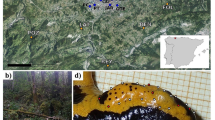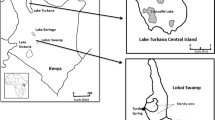Abstract
Variation in local environments may lead to variation in the selection pressures and differentiation among local populations even at microgeographic scale. We investigated variation in temperature-induced plasticity in larval life-history traits among populations of an isolated pool frog (Rana lessonae) metapopulation in Central Sweden. Successful breeding of this northern fringe metapopulation is highly dependent on early summer temperature, however, the metapopulation shows very little variation in molecular genetic markers suggesting limited potential for local differentiation. We exposed larvae from three closely-located populations to two temperatures (20 and 25°C) in laboratory to investigate their growth and development responses to temperature variation. In general, larvae exposed to warmer temperature experienced higher survival and metamorphosed faster, but at a smaller size than those at low temperature. We found differences among the populations in both trait mean values and in the plastic responses. Among-family variation within populations was found in growth rate and time to metamorphosis, as well as in plasticity suggesting that these traits have a capacity to evolve. Our results indicate ample phenotypic variation within and among these closely-located populations despite the low molecular genetic variation. The differences in pond temperature characteristics detected in the study in the three localities may suggest that differential selection is acting in the populations. The strong differentiation found in the larval traits implies that understanding the factors that influence the potential of the populations to adapt to environmental changes may be essential for successful conservation strategies.



Similar content being viewed by others
References
APHA (1985) Standard methods for the examination of water and wastewater, 16th edn. American Public Heath Association, Washington
Atkinson D (1996) Ectotherm life-history responses to developmental temperature. In: Johnston IA, Benett AF (eds) Animals and temperature: phenotypic and evolutionary adaptation. Cambridge Univ Press, Cambridge, pp 183–204
Beebee TJC (2005) Conservation genetics of amphibians. Heredity 95:423–427. doi:10.1038/sj.hdy.6800736
Bell DL, Galloway LF (2008) Population differentiation for plasticity to light in an annual herb: adaptation and cost. Am J Bot 95:59–65. doi:10.3732/ajb.95.1.59
Berg H, Becker U, Matthies D (2005) Phenotypic plasticity in Carlina vulgaris: effects of geographical origin, population size, and population isolation. Oecologia 143:220–231. doi:10.1007/s00442-004-1801-2
Blows MW, Hoffmann AA (1993) The genetics of central and marginal populations of Drosophila serrata I. genetic variation for stress resistance and species borders. Evol Int J Org Evol 47:1255–1270. doi:10.2307/2409990
DeWitt TJ, Scheiner SM (2004) Phenotypic plasticity: functional and conceptual approaches. Oxford Univ Press, Oxford
DeWitt TJ, Sih A, Wilson DS (1998) Costs and limits of phenotypic plasticity. Trends Ecol Evol 13:77–81. doi:10.1016/S0169-5347(97)01274-3
Freidenburg LK, Skelly DK (2004) Microgeographical variation in thermal preference by an amphibian. Ecol Lett 7:369–373. doi:10.1111/j.1461-0248.2004.00587.x
Gosner KN (1960) A simplified table for staging anuran embryos and larvae with notes on identification. Herpetologica 16:183–190
Gotthard K, Nylin S (1995) Adaptive plasticity and plasticity as an adaptation: a selective review of plasticity in animal morphology and life-history. Oikos 74:3–17. doi:10.2307/3545669
Hampe A, Petit RJ (2005) Conserving biodiversity under climate change: the rear edge matters. Ecol Lett 8:461–467. doi:10.1111/j.1461-0248.2005.00739.x
Hendry AP, Kinnison MT, Day T, Taylor EB (2001) Population mixing and the adaptive divergence of quantitative traits in discrete populations: a theoretical framework for empirical test. Evol Int J Org Evol 55:459–466. doi:10.1554/0014-3820(2001)055[0459:PMATAD]2.0.CO;2
Kingsolver JG, Gomulkiewicz R (2003) Environmental variation and selection on performance curves. Integr Comp Biol 43:470–477. doi:10.1093/icb/43.3.470
Kingsolver JG, Massie KR, Shlichta JG, Smith MH, Ragland GJ, Gomulkiewicz R (2007) Relating environmental variation to selection on reaction norms: an experimental test. Am Nat 169:163–174. doi:10.1086/510631
Länsstyrelsen i Uppsala län (2007) 2005 års inventering av gölgroda längs Nordupplands kustband samt utvärdering av gölgrodans åtgärdsprogram. Länsstyrelsens meddelandeserie 2007: 1. Länsstyrelsen i Uppsala län, Uppsala, Sweden
Leinonen T, O’Hara RB, Cano JM, Merilä J (2008) Comparative studies of quantitative trait and neutral marker divergence: A meta-analysis. J Evol Biol 21:1–17
Lemckert FL (2004) Variations in anuran movement and habitat use: implications for conservation. Appl Herpetol 1:165–181. doi:10.1163/157075403323012179
Lind MI, Johansson F (2007) The degree of adaptive phenotypic plasticity is correlated with the spatial environmental heterogeneity experienced by island populations of Rana temporaria. J Evol Biol 20:1288–1297. doi:10.1111/j.1420-9101.2007.01353.x
Littell RC, Milliken GA, Stroup WW, Wolfinger RD, Schabenberger O (2006) SAS® for mixed models, vol 2. SAS Institute Inc, Cary
Media Cybernetics (1993) Image Pro Plus 1.1 for Windows. Media Cybernetics, Bethesda, USA
Merilä J, Crnokrak P (2001) Comparison of genetic differentiation at marker loci and quantitative traits. J Evol Biol 14:892–903. doi:10.1046/j.1420-9101.2001.00348.x
Merilä J, Laurila A, Lindgren B (2004) Variation in the degree and costs of adaptive phenotypic plasticity among Rana temporaria populations. J Evol Biol 17:1132–1140. doi:10.1111/j.1420-9101.2004.00744.x
Newman RA (1992) Adaptive plasticity in anuran metamorphosis. Bioscience 42:671–678. doi:10.2307/1312173
Pigliucci M (2001) Phenotypic plasticity: beyond nature and nurture. The Johns Hopkins Univ Press, Baltimore
Roff DA (1997) Evolutionary quantitative genetics. Chapman & Hall, New York
Scheiner SM (1993) Genetics and evolution of phenotypic plasticity. Annu Rev Ecol Syst 24:35–68. doi:10.1146/annurev.es.24.110193.000343
Semlitsch RD (1993) Adaptive genetic variation in growth and development of tadpoles of the hybridogenetic Rana esculenta complex. Evol Int J Org Evol 47:1805–1818. doi:10.2307/2410223
Sinsch U (1984) Thermal influences on the habitual preference and the diurnal activity in three European Rana species. Oecologia 64:125–131. doi:10.1007/BF00377554
Sjögren P (1991a) Extinction and isolation gradients in metapopulations: the case if the pool frog (Rana lessonae). Biol J Linn Soc Lond 42:135–147. doi:10.1111/j.1095-8312.1991.tb00556.x
Sjögren P (1991b) Genetic variation in relation to demography of peripheral pool frog populations (Rana lessonae). Evol Ecol 5:248–271. doi:10.1007/BF02214231
Sjögren P, Elmberg J, Berglind S-Å (1988) Thermal preferences in the pool frog Rana lessonae: impact on the reproductive behaviour of a northern fringe population. Holarct Ecol 11:178–184
Skelly DK (2004) Microgeographic countergradient variation in the wood frog, Rana sylvatica. Evol Int J Org Evol 58:160–165
Smith-Gill SJ, Berven KA (1979) Predicting amphibian metamorphosis. Am Nat 113:563–585. doi:10.1086/283413
Snell C, Tetteh J, Evans IH (2005) Phylogeography of the pool frog (Rana lessonae Camerano) in Europe: evidence for native status in Great Britain and for an unusual postglacial colonization route. Biol J Linn Soc Lond 85:41–51. doi:10.1111/j.1095-8312.2005.00471.x
SPSS (2004) SPSS 13.0 release for Windows. SPSS Inc, Chicago
Storfer A (1996) Quantitative genetics: a promising approach for the assessment of genetic variation in endangered species. Trends Ecol Evol 11:343–348. doi:10.1016/0169-5347(96)20051-5
Tietje GA, Reyer H-U (2004) Larval development and recruitment of juveniles in a natural population of Rana lessonae and Rana esculenta. Copeia 2004:638–646. doi:10.1643/CE-03-273R1
Van Buskirk J (2002) A comparative test of the adaptive plasticity hypothesis: relationships between habitat and phenotype in anuran larvae. Am Nat 160:87–102. doi:10.1086/340599
Van Buskirk J, Arioli M (2005) Habitat specialization and adaptive divergence of anuran populations. J Evol Biol 18:596–608. doi:10.1111/j.1420-9101.2004.00869.x
Wells KD (2007) The ecology and behaviour of amphibians. The Univ of Chicago Press, Chicago
Willi Y, Van Buskirk J, Hoffmann AA (2006) Limits to the adaptive potential of small populations. Annu Rev Ecol Evol Syst 37:433–458. doi:10.1146/annurev.ecolsys.37.091305.110145
Zeisset I, Beebee TJC (2001) Determination of biogeographical range: an application of molecular phylogeography to the European pool frog Rana lessonae. Proc R Soc Lond B Biol Sci 268:933–938. doi:10.1098/rspb.2001.1600
Acknowledgments
Emma Dahl and Anaelisa Valdés gave us invaluable help during the field and laboratory work. We thank Miguel Tejedo and Céline Teplitsky for constructive comments on an earlier version of the manuscript. Our research was supported by a post-doctoral fellowship of the Spanish Ministry of Education and Science and fellowships from Fundación Caja Madrid and Fundación Ramón Areces (to G.O.), and by the Swedish Research Council for Environment, Agricultural Sciences and Spatial Planning (to A.L.). The experiments were conducted in agreement with the national laws and the eggs were collected with permission from the county authorities (Länsstyrelsen i Uppsala Län).
Author information
Authors and Affiliations
Corresponding author
Rights and permissions
About this article
Cite this article
Orizaola, G., Laurila, A. Microgeographic variation in temperature-induced plasticity in an isolated amphibian metapopulation. Evol Ecol 23, 979–991 (2009). https://doi.org/10.1007/s10682-008-9285-x
Received:
Accepted:
Published:
Issue Date:
DOI: https://doi.org/10.1007/s10682-008-9285-x




